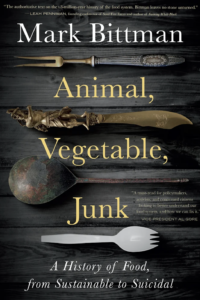Mark Bittman: We Need an Agroecological Revolution
Towards a Sustainable and Equitable System of
Global Food Production
The word “agroecology” was first used about a hundred years ago, and it remains the best descriptor for the movements that are rebuilding our relationship with food. The word and practices have been advanced by the global peasant organization La Via Campesina (“the Peasant Way”) for decades, and that—along with the fact that, moving forward, agroecology is the most sensible approach for agriculture—has led to its use and at least partial endorsement by the governments of France, Cuba, and others, and by the UN’s Food and Agriculture Organization, which included agroecology as a key component of its 2030 Sustainable Development Goals.
For those reasons—and because “producing food in harmony with the planet and its inhabitants” is a mouthful—“agroecology” is the word I’m sticking with. It’s a clunky term, but perhaps its unsexiness is an advantage: It’s not likely to be co-opted as quickly as “natural” and “organic” were; it’s hard to imagine “agroecological” power bars or potato chips, though stranger things have happened.
As you can guess, agroecology is a set of practices that integrates ecological principles into agriculture. As a scientific approach to farming that works with all of nature’s power and gifts, rather than seeing nature as something to be conquered, it stands in opposition to industrial agriculture. It is more serious and comprehensive than “organic,” and not constrained by USDA definitions.
But agroecology is more than just a series of techniques—it’s a philosophy and a broad commitment to improve society. Adherents define it as “an autonomous, pluralist, multicultural movement, political in its demand for social justice.” That’s key.
Farmers worldwide are struggling to maintain or regain control of their food supply while rejecting the global norms of “development” and “underdevelopment”—norms that mandate urbanization, industrialization, “efficiency,” and large scale. La Via Campesina, which is a loose coalition of two hundred million farmers and activists, organizes for food sovereignty: Its goals are to get land to the landless and to enable farmers to control what they produce while making a living and stewarding the earth.
One of agroecology’s best Western advocates is former University of California–Santa Cruz professor Steve Gliessman. In the tradition of Albert Howard, Franklin Hiram King, and Rudolf Steiner, Gliessman traveled the world and saw how the strength and good sense of peasant agriculture contrasted with the fragility and recklessness of industrial agriculture.
Gliessman argues that developing an agroecological system would ultimately transform the global food system by first cutting back on the toxic techniques innate to industrial agriculture, starting with chemical fertilizer and pesticides.
Next comes replacing those materials and their associated techniques with alternative practices, such as the use of compost, cover crops, crop rotation, and multicropping; the encouragement of beneficial animal and plant interactions; and the complete elimination of chemicals. To this point, what we’re really talking about is organic farming, but this is where farmers will begin to rebuild the system, using from-the-farm fertilizer, intercropping—planting a number of crops together—to reduce pests and unwanted plants, encouraging pollinators, and generally, in Gliessman’s words, functioning “on the basis of a new set of ecological processes.” The next step involves shortening the food supply chain, reducing the distance between growers and eaters, and establishing new ways of getting food to people.
Finally—and this can’t happen without widespread societal change in all arenas, including the economy—the global food system must become sustainable and equitable for all.
No question: a tall order. The alternative is catastrophic.
“Eating is an agricultural act,” says Wendell Berry, which is to say, food does not come from nowhere; it comes from land and people. In turn, agriculture is a political act: The policies and investments we decide on as a society determine what agriculture we practice.
How we relate to land and the food we grow has everything to do with how we live on the earth, and who benefits and suffers from that treatment. Thus, agroecology is about not only sane agricultural methods but the empowerment of women and groups of long-exploited people, such as BIPOC, land reform, fair distribution of resources and treatment of labor, affordable food, nutrition and diet, and animal welfare.
Gliessman argues that developing an agroecological system would ultimately transform the global food system by first cutting back on the toxic techniques innate to industrial agriculture, starting with chemical fertilizer and pesticides.Agroecology aims to right social wrongs. The movements for global justice and truly sustainable growing techniques are interwoven, and agroecological change can’t simply stop at the first or second steps outlined above. The other yardsticks include how well food nourishes people, protects the environment, and helps farmers lead good lives. Agroecology regenerates the ecology of the soil instead of depleting it, reduces carbon emissions, and sustains local food cultures, businesses, farms, jobs, seeds, and people instead of diminishing or destroying them.
To date, agroecology has received little government research support, maybe five percent of that given to industrial agriculture. Yet agroecology has repeatedly demonstrated that focusing on growing in harmony with nature can be profitable, productive, and enduring. Even within the framework of industrial agriculture, reducing the use of chemicals and patented seeds cuts costs significantly, and yields remain stable or even rise as soil health improves.
Agroecology supports farming as a dignified way to live, creating grounding, family-oriented, life-giving work. We can call that “rural employment” or “revitalization” or “green jobs.” With the best ideas and methods of industrial agriculture integrated into a more sensible and equitable system, farming need not involve the drudgery so many millions want to escape.
Thankfully, progressive governments everywhere, from the City of Philadelphia to the Pacific nation of Vanuatu and scores of others in between, have recognized the destructive nature of industrially produced food and begun to act accordingly. The progress is, to many, almost invisible. But it exists. Whether it’s enough remains to be seen, but agroecology is hands-down our best bet for changing agriculture’s role from a driver of the greatest problems afflicting humankind to a solution.
Some of these may at first sound minor and extremely incremental; and they are incremental, but they are decidedly not minor, because they are among the steps outlined by agroecology, and include the beginning of the end of monoculture, more thoughtfulness and fairness in the food system, a more rational way of production. Acknowledging that industrial agriculture is not likely to go away anytime soon means accepting the value of steps that can be taken to mitigate its harshest effects while recognizing those steps that showcase real alternatives and progress. That’s what follows.
Yet agroecology has repeatedly demonstrated that focusing on growing in harmony with nature can be profitable, productive, and enduring.*
It starts and ends with land and people. The mistakes of the past cannot be changed, but they can be remedied; this requires a shift in power. Power is at the nexus of all the interlocking issues that define the food system, and an ethical restructuring of food systems must right the historical wrongs of land and wealth distribution and empower the world’s most vulnerable people. You can call these changes evolution or revolution, but they will mean the true self-determination of the world’s majority of people, which is only right.
Food is central to this, as it is to most things, and food is produced by people. Improving the food system does not mean less involvement by people but more. Treating the land right—reducing monoculture and its ills—is a laborious job.
More labor will indeed threaten industry profits (which are unjustifiably high) and raise consumer prices (which are artificially low). These economic failures are in part due to the industry’s ability to ignore “externalities,” such as the costs of environmental damage, declining public health, and even food stamps for underpaid workers—all costs that the industry has historically skirted to boost profit margins.
As corporations are held more responsible for these costs, the basic truths about whom the food system serves will be laid more bare. What happens next is anyone’s guess, but low wages are the last bulwark of the industrial food system—indeed, of the economic system itself.
Addressing mistreated workers in our food system will require a cascade of changes to the status quo, which makes it a good place to start. And awareness of food-chain labor has accelerated in recent years. It’s no coincidence that the “Fight for $15”—the movement to institute a minimum hourly wage of fifteen dollars in place of the current federal minimum of $7.25—began at KFC, McDonald’s, and Burger King. In 2012, about two hundred New York City fast-food workers risked their jobs (and, for many, their immigration status) to demand the still-meager wage of fifteen dollars per hour.
Improving the food system does not mean less involvement by people but more. Treating the land right—reducing monoculture and its ills—is a laborious job.As of this writing, estimates put the gains made by the Fight for $15 at more than seventy billion dollars for more than twenty million workers. Many states have raised minimum wages, with a handful establishing the fifteen-dollar standard. Others have done away with the exploitative tipped wage. (California has done both.) It’s likely that the next time Democrats have a president in the White House and a majority in Congress, the national minimum wage will be bumped to fifteen dollars per hour, and we’ll see tipped wages phased out nationally.
Farmworkers, too, have made progress. The best known example of this is in Florida, which has long provided most of the country’s winter tomatoes. For decades, South Florida farm bosses underpaid, mistreated, and sometimes literally imprisoned workers, the majority of whom are immigrants. In 1993, the Coalition of Immokalee Workers, named after the town where it’s based, a tomato-growing center, set out to change that.
Demonizing growers was the most obvious way to curb abuse and raise wages, but organizers recognized that the real power lay not with the relatively small farm owners, who were themselves burdened with low margins and an otherwise tricky business, but with their customers—the buyers for supermarkets and fast-food chains, who demanded ever-decreasing prices. So, beginning in 2001, the organization targeted the big boys.
After a four-year battle involving coalitions of students, labor activists, and others, Taco Bell agreed to pay a penny more per pound for tomatoes and to buy only from farms committed to CIW’s Fair Food Code of Conduct. Since then, thirteen more major foods brands have signed on, and the penny-per-pound increase has translated into nearly thirty-five million dollars in added wages. By signing the code, employers guarantee that their workers will “not be the victims of forced labor, child labor, or violence . . . go to work without being sexually harassed or verbally abused . . . have shade, clean drinking water, and bathrooms in the fields . . . be permitted to leave the fields when there is lightning, pesticide spraying, or other dangerous conditions,” and be entitled to a handful of other protections.
Today, participating buyers in the Fair Food Program include many supermarkets and fast-food chains, most notably Walmart. Ninety percent of tomato producers in Florida and six other eastern states have signed on to the Fair Food Code of Conduct, and farms that don’t meet the code’s terms are expelled from the program and thus unable to sell to big buyers who’ve committed to it. Improved working conditions have brought about a more stable workforce that includes about 35,000 decently treated laborers.
Demonizing growers was the most obvious way to curb abuse and raise wages, but organizers recognized that the real power lay not with the relatively small farm owners but with their customers.And the model is spreading. There is now a Milk with Dignity Standards Council, with its own code of conduct, working to improve rights for dairy-chain workers.
Nevertheless, most farmworkers—many of whom are undocumented and consequently live in fear of deportation—still lack organizing rights, limits on workweek length, codes for sanitary housing, disability insurance, family leave, or eligibility for unemployment or overtime pay. These protections are guaranteed to most other workers, but not to those who do the work no one else wants to do—producing the food we eat.
Progress was made on this front in New York in 2019, when the Farm Laborers Fair Labor Practices Act was signed into law, righting a wrong that excluded agricultural laborers from the 1938 Fair Labor Standards Act. This made New York a safer, more dignified, and union-friendly place for nearly 100,000 farm laborers. The law includes provisions for collective bargaining, time-and-a-half pay after sixty hours worked in a week, an option for a full day of rest each week, and other long-overdue provisions.
California also made improvements in laws protecting farmworkers, including provisions for overtime pay, and as of this writing, Washington State’s supreme court is hearing a case that would decide whether it’s constitutional to exclude farmworkers from overtime guarantees. The decision could have implications for a future federal ruling and hopefully pave the way for lasting change.
__________________________________

Excerpted from Animal, Vegetable, Junk © 2021 by Mark Bittman. Reproduced by permission of Houghton Mifflin Harcourt. All rights reserved.




















